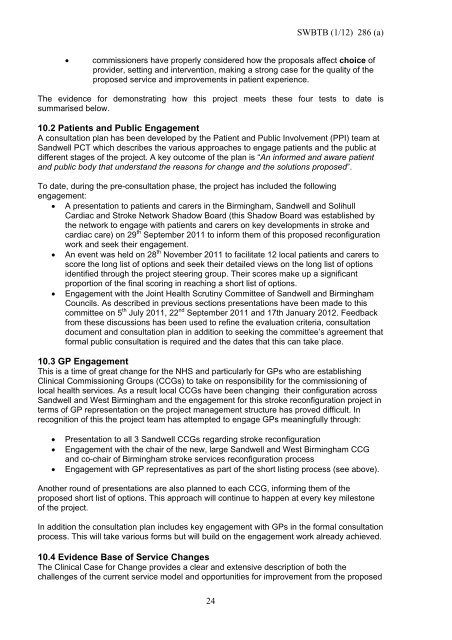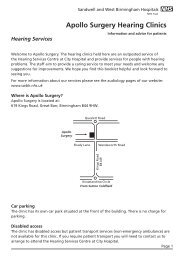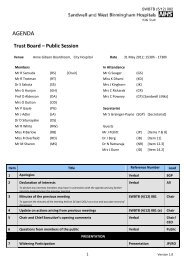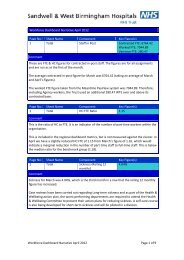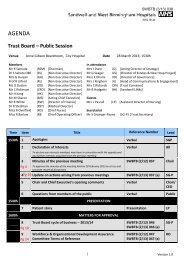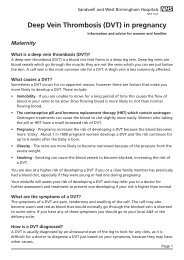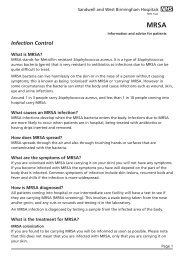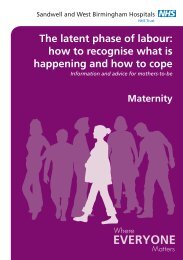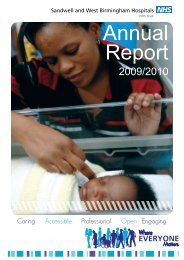January 2012 - Sandwell & West Birmingham Hospitals
January 2012 - Sandwell & West Birmingham Hospitals
January 2012 - Sandwell & West Birmingham Hospitals
Create successful ePaper yourself
Turn your PDF publications into a flip-book with our unique Google optimized e-Paper software.
SWBTB (1/12) 286 (a)<br />
<br />
commissioners have properly considered how the proposals affect choice of<br />
provider, setting and intervention, making a strong case for the quality of the<br />
proposed service and improvements in patient experience.<br />
The evidence for demonstrating how this project meets these four tests to date is<br />
summarised below.<br />
10.2 Patients and Public Engagement<br />
A consultation plan has been developed by the Patient and Public Involvement (PPI) team at<br />
<strong>Sandwell</strong> PCT which describes the various approaches to engage patients and the public at<br />
different stages of the project. A key outcome of the plan is “An informed and aware patient<br />
and public body that understand the reasons for change and the solutions proposed”.<br />
To date, during the pre-consultation phase, the project has included the following<br />
engagement:<br />
A presentation to patients and carers in the <strong>Birmingham</strong>, <strong>Sandwell</strong> and Solihull<br />
Cardiac and Stroke Network Shadow Board (this Shadow Board was established by<br />
the network to engage with patients and carers on key developments in stroke and<br />
cardiac care) on 29 th September 2011 to inform them of this proposed reconfiguration<br />
work and seek their engagement.<br />
An event was held on 28 th November 2011 to facilitate 12 local patients and carers to<br />
score the long list of options and seek their detailed views on the long list of options<br />
identified through the project steering group. Their scores make up a significant<br />
proportion of the final scoring in reaching a short list of options.<br />
Engagement with the Joint Health Scrutiny Committee of <strong>Sandwell</strong> and <strong>Birmingham</strong><br />
Councils. As described in previous sections presentations have been made to this<br />
committee on 5 th July 2011, 22 nd September 2011 and 17th <strong>January</strong> <strong>2012</strong>. Feedback<br />
from these discussions has been used to refine the evaluation criteria, consultation<br />
document and consultation plan in addition to seeking the committee’s agreement that<br />
formal public consultation is required and the dates that this can take place.<br />
10.3 GP Engagement<br />
This is a time of great change for the NHS and particularly for GPs who are establishing<br />
Clinical Commissioning Groups (CCGs) to take on responsibility for the commissioning of<br />
local health services. As a result local CCGs have been changing their configuration across<br />
<strong>Sandwell</strong> and <strong>West</strong> <strong>Birmingham</strong> and the engagement for this stroke reconfiguration project in<br />
terms of GP representation on the project management structure has proved difficult. In<br />
recognition of this the project team has attempted to engage GPs meaningfully through:<br />
<br />
<br />
<br />
Presentation to all 3 <strong>Sandwell</strong> CCGs regarding stroke reconfiguration<br />
Engagement with the chair of the new, large <strong>Sandwell</strong> and <strong>West</strong> <strong>Birmingham</strong> CCG<br />
and co-chair of <strong>Birmingham</strong> stroke services reconfiguration process<br />
Engagement with GP representatives as part of the short listing process (see above).<br />
Another round of presentations are also planned to each CCG, informing them of the<br />
proposed short list of options. This approach will continue to happen at every key milestone<br />
of the project.<br />
In addition the consultation plan includes key engagement with GPs in the formal consultation<br />
process. This will take various forms but will build on the engagement work already achieved.<br />
10.4 Evidence Base of Service Changes<br />
The Clinical Case for Change provides a clear and extensive description of both the<br />
challenges of the current service model and opportunities for improvement from the proposed<br />
24


